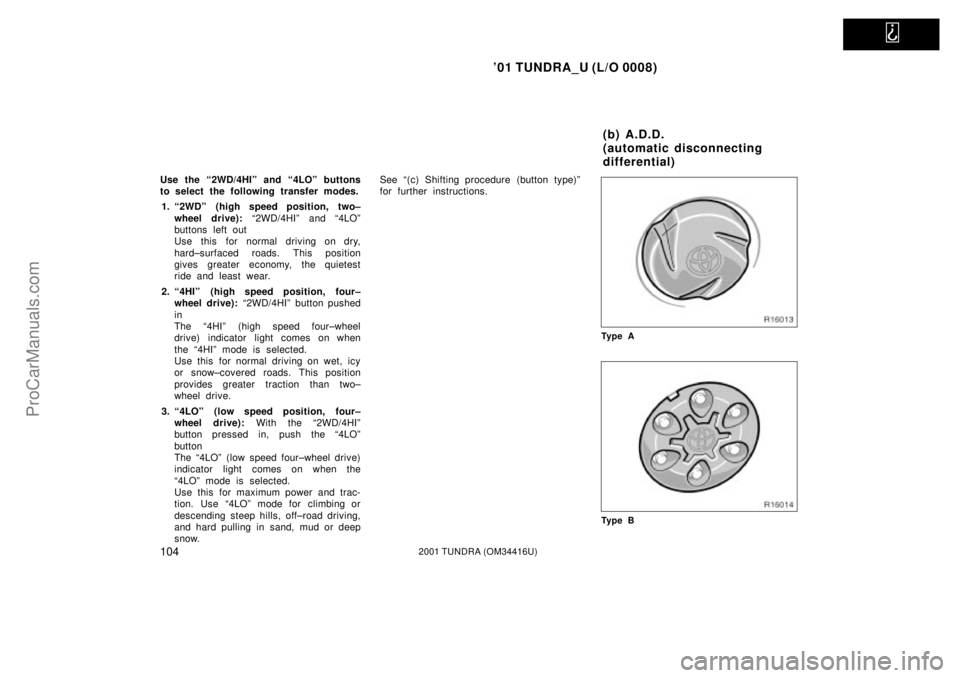Page 111 of 297

'01 TUNDRA_U (L/O 0008)
1042001 TUNDRA (OM 34416U)
Use the ª2WD/4HIº and ª4LOº buttons
to select the following transfer modes.
1. ª2WDº (high speed position, two± wheel drive): ª2WD/4HIº and ª4LOº
buttons left out
Use this for normal driving on dry,
hard±surfaced roads. This position
gives greater economy, the quietest
ride and least wear.
2. ª4HIº (high speed position, four± wheel drive): ª2WD/4HIº button pushed
in
The ª4HIº (high speed four±wheel
drive) indicator light comes on when
the ª4HIº mode is selected.
Use this for normal driving on wet, icy
or snow±covered roads. This position
provides greater traction than two±
wheel drive.
3. ª4LOº (low speed position, four± wheel drive): With the ª2WD/4HIº
button pressed in, push the ª4LOº
button
The ª4LOº (low speed four±wheel drive)
indicator light comes on when the
ª4LOº mode is selected.
Use this for maximum power and trac-
tion. Use ª4LOº mode for climbing or
descending steep h ills, off±road driving,
and hard pulling in s and, mud or deep
snow. See ª(c) Shifting procedure (button type)º
for further instructions.
Ty p e A
Ty p e B
(b) A.D.D.
(automatic disconnecting
differential)
ProCarManuals.com
Page 197 of 297

'01 TUNDRA_U (L/O 0008)
1892001 TUNDRA (OM 34416U)
�U.S. Forest Service and Bureau of
Land Management
CAUTION
Always observe the following precau-
tions to minimize the risk of serious
personal injury or damage to your ve-
hicle:
�Drive carefully when off the road.
Do not take unnecessary risks by
driving in dangerous places.
�Do not grip the steering wheel
spokes when driving off±road. A
bad bump could jerk the wheel and
injure your hands. Keep both hands
and especially your thumbs on the
outside of the rim.
�Always check your brakes for effec-
tiveness immediately after driving in
sand, mud, water or snow.
�After driving through tall grass,
mud, rock, sand, rivers, etc., check
that there is no grass, bush, paper,
rags, stone, sand, etc. adhering or
trapped on the underbody. Clear off
any such matter from the under-
body. If the vehicle is used with
these materials trapped or adhering
to the underbody, a breakdown or
fire could occur.
�In a rollover crash, an unbelted per-
son is significantly more likely to
die than a person wearing a seat
belt. Therefore, the driver and all
passengers should fasten their seat
belts whenever the vehicle is mov-
ing.
�When driving off±road or in rugged
terrain, do not drive at excessive
speeds, jump, make sharp turns,
strike objects, etc. This may cause
loss of control or vehicle rollover
causing death or serious injury. You
are also risking expensive damage
to your vehicle's suspension and
chassis.
NOTICE
�If driving through water, such as
when crossing shallow streams,first check the depth of the waterand the bottom of the river bed for
firmness. Drive slowly and avoiddeep water.
�Take all necessary safety measures
to ensure that water damage to theengine or other components doesnot occur.
Water entering the engine air intakewill cause severe engine damage.
Water can wash the grease fromwheel bearings, causing rusting and
premature failure, and may also en-ter the differentials, transmissionand transfer case, reducing the gear
oil's lubricating qualities.
�Sand and mud that has accumulatedin brake drums and around brake
discs may affect braking efficiencyand may damage brake system com-ponents.
ProCarManuals.com
Page 283 of 297

'01 TUNDRA_U (L/O 0008)
2752001 TUNDRA (OM 34416U)
TRANSFER
Oil capacity, L (qt., Imp. qt.):
1.0 (1.1, 0.9)
Oil type: Gear oil API GL±4 or GL±5
Recommended oil viscosity: SAE 75W±90
DIFFERENTIAL
Oil capacity, L (qt., Imp. qt.): Front1.15 (1.2, 1.0)
Rear
Two±wheel drive models3.80 (4.0, 3.3)
Four±wheel drive models 3.50 (3.7, 3.1)
Oil type: Hypoid gear oil API GL±5
Recommended oil viscosity: Front SAE 75W±90
Rear Above ±18 �C (0 �F)
SAE 90
Below ±18 �C (0 �F)
SAE 80W or 80W±90 CHASSIS LUBRICATION
Propeller shafts:
Spiders and slide yokesLithium base chassis grease, NLGI
No.2
Double cardan joint Molybdenum±disulfide lithium base
chassis grease, NLGI No.2
BRAKES
Minimum pedal clearance when depressed
with the force of 490 N (50 kgf, 110 lbf)
with the engine running, mm (in.): 95 (3.7)
Pedal free play, mm (in.): 1Ð6 (0.04Ð0.24)
Pad wear limit, mm (in.): 1.0 (0.04)
Lining wear limit, mm (in.): 1.0 (0.04)
Parking brake adjustment: Pedal typeÐwhen depressed with the
force of 294 N (30 kgf, 66.1 lbf)5Ð8 clicks
Lever typeÐwhen pulled with the force
of 196 N (20 kgf, 44 lbf) 4Ð12 clicks
Fluid type: SAE J1703 or FMVSS No.116 DOT 3 STEERING
Wheel free play:
Less than 30 mm (1.2 in.)
Power steering fluid type: Automatic transmission fluid DEXRON �II
or III
ProCarManuals.com